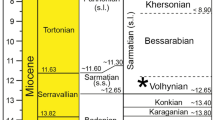Abstract
A partial skeleton of a new fossil loon (Aves, Gaviiformes), ?Colymboides metzleri n.sp., is described from the early Oligocene (Rupelian) of Frauenweiler in Germany. The new species resembles the early Miocene species Colymboides minutus in size and overall morphology, but differs in several osteological details. The specimen represents the first associated remains of an early Tertiary loon. Preserved stomach content further provides the first direct evidence that early Tertiary loons were already specialized towards a piscivorous diet, hunting fishes in a marine environment.




Similar content being viewed by others
References
Baumel JJ, Witmer LM (1993) Osteologia. In: Baumel JJ, King AS, Breazile JE, Evans HE, Vanden Berge JC (eds) Handbook of avian anatomy: Nomina anatomica avium. Publ Nuttall Ornithol Club 23:45–132
Carboneras C (1992) Family Gaviidae (Divers). In: del Hoyo J, Elliott A, Sargatal J (eds) Handbook of the birds of the world, vol 1Lynx Edicions, Barcelona, pp 162–172
Chatterjee S (1997) The rise of birds. John Hopkins University Press, Baltimore
Chatterjee S (2002) The morphology and systematics of Polarornis, a Cretaceous Loon (Aves: Gaviidae) from Antarctica. In: Zhou Z, Zhang F (eds) Proceedings of the 5th Symposium of the Society of Avian Paleontology and Evolution, Beijing, 1–4 June 2000. Science Press, Beijing,.pp 125–155
Cheneval J (1984) Les oiseaux aquatiques (Gaviiformes à Ansériformes) du gisement aquitanien de Saint-Gérand-le-Puy (Allier, France): Révision systématique. Palaeovertebrata 14:33–115
Harrison CJO, Walker CA (1976) Birds of the British Upper Eocene. Zool J Linn Soc 59:323–351
Legendre S, Lévêque F (1997) Etalonnage de l’échelle biochronologique mammalienne du Paléogène d’Europe occidentale: vers une intégration à l’échelle globale. In: Aguilar J-P, Legendre S, Michaux J (eds) Actes du Congrès BiochroM’97. Mém Trav EPHE Inst Montpellier 21:461–473
Lydekker R (1891) Catalogue of the fossil birds in the British Museum (Natural History). British Museum (Natural History), London
Mayr G (2000) A new mousebird (Coliiformes: Coliidae) from the Oligocene of Germany. J Ornithol 141:85–92
Mayr G (2004a) Morphological evidence for sister group relationship between flamingos (Aves: Phoenicopteridae) and grebes (Podicipedidae). Zool J Linn Soc 140:157–169
Mayr G (2004b) Old World fossil record of modern-type hummingbirds. Science 304:861–864
Mayr G, Manegold A (2004) The oldest European fossil songbird from the early Oligocene of Germany. Naturwissenschaften 91:173–177
Mayr G, Smith R (2002) Avian remains from the lowermost Oligocene of Hoogbutsel (Belgium). Bull Inst R Sci Nat Belg 72:139–150
Mayr G, Peters DS, Rietschel, S (2002) Petrel-like birds with a peculiar foot morphology from the Oligocene of Germany and Belgium (Aves: Procellariiformes). J Vert Paleontol 22:667–676
Micklich N, Parin N (1996) The fishfauna of Frauenweiler (Middle Oligocene, Rupelian; Germany): First results of a review. Publ Espec Inst Esp Oceanogr 21:129–148
Milne-Edwards A (1867–1871) Recherches anatomiques et paléontologiques pour servir à l’histoire des oiseaux fossiles de la France. Masson, Paris
Mlíkovský J (1996) Tertiary avian localities of the United Kingdom. In: Mlíkovský J (ed) Tertiary avian localities of Europe. Acta Univ Carol 39:759–771
Mlíkovský J (2002) Cenozoic birds of the world. Part 1: Europe. Ninox, Praha
Olson SL (1992) Neogaeornis wetzeli Lambrecht, a Cretaceous loon from Chile (Aves: Gaviidae). J Vert Paleontol 12:122–124
Olson SL, Rasmussen PC (2001) Miocene and Pliocene birds from the Lee Creek Mine, North Carolina. In: Ray CE, Bohaska DJ (eds) Geology and paleontology of the Lee Creek Mine, North Carolina, III. Smithson Contrib Paleobiol 90:233–365
Shufeldt RW (1915) Fossil birds in the Marsh Collection of Yale University. Yale University Press, New Haven
Sibley CG, Ahlquist JE (1990) Phylogeny and classification of birds: a study in molecular evolution. Yale University Press, New Haven
Storer RW (1956) The fossil loon, Colymboides minutus. Condor 58:413–426
Švec P (1980) Lower Miocene birds from Dolnice (Cheb basin), western Bohemia. Cas Mineral Geol 25:377–387
Švec P (1982) Two new species of diving birds from the Lower Miocene of Czechoslovakia. Cas Mineral Geol 27:243–260
Trunkó L, Munk W (1998) Geologische Beobachtungen in drei tertiären Aufschlußkomplexen im Randbereich des Mittleren Rheingrabens. Carolinea 56:9–28
Tuinen M van, Butvill DB, Kirsch JAW, Hedges SB (2001) Convergence and divergence in the evolution of aquatic birds. Proc R Soc Lond B 268:1345–1350
Wetmore A (1940) Fossil bird remains from Tertiary deposits in the United States. J Morphol 66:25–37
Acknowledgements
I thank R. Böttcher (SMNS) for the loan of the fossil specimen, O. Vogel for its further preparation, and S. Tränkner for taking the photographs.
Author information
Authors and Affiliations
Corresponding author
Additional information
Communicated by F. Bairlein
Rights and permissions
About this article
Cite this article
Mayr, G. A partial skeleton of a new fossil loon (Aves, Gaviiformes) from the early Oligocene of Germany with preserved stomach content. J Ornithol 145, 281–286 (2004). https://doi.org/10.1007/s10336-004-0050-9
Received:
Revised:
Accepted:
Published:
Issue Date:
DOI: https://doi.org/10.1007/s10336-004-0050-9




